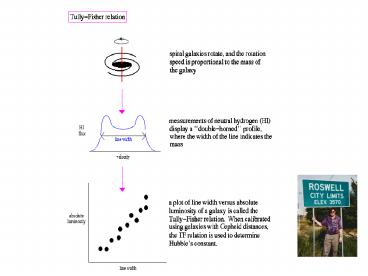Now what PowerPoint PPT Presentation
Title: Now what
1
(No Transcript)
2
Why is Rotation Speed Proportional to Mass?
mv2/R GMm/R2 centrifugal force
gravitational force due to the mass M within
the radius R.
gt Measure v and you produce a curve that
describes v versus M
3
Jackson-Faber
- Similar to Tully-Fisher, except for
- Elliptical galaxies
- width of visible star light lines are the
measured - Refined does even better.
- The fundamental plane.
- Adds surface brightness of the galaxy.
- Plane formed fromgt
4
Fundamental Plane
Line width
Luminosity
Surface brightness
3 points determine a plane
5
- Line width results from?? gt
- The lines come from individual stars.
- The stars are orbiting the galaxy center that
when we add up the light from all the stars
6
Ways to make lines broad
- Intrinsic transition rate
- Thermal motion of atoms due to heat
- Bulk motior (needed for Jackson-Faber)
gt To detect it, we must have bulk motion be
large enough to see on top of other effects
7
- Luminosity total intrinsic light output
- Surface brightness Flux/(solid angle),
- Flux L/4pD2
- Solid angle pr2/D2, where
- D the distance to the object
- r the radius of the object
- Surface brightness is independent of distance
(ignoring relativity and GR)
8
- Measuring radius of a fuzzy object at a given
surface brightness level good - For the same objects at different distances
gives the same true radius
9
Flux x 1/solid angle
Concept different from luminosity. The key is
the concept of solid angle
pr2/D2 solid angle p(r/D)2 p(q/2)2
Sky patch
r
Angle of cone
q
D
gt Angle area of cone p(q/2)2
Solid angle
10
- gt Physical concept is
- Higher the surface brightness
- The better a object stands out against the
background
11
For our small angles (less then about 1 degree),
q r/D where r the physical actual radius of
the objects projected image on the sky and D
the distance to the object
sin(q/2)
r/D tan(q/2)
r
q/2 in radians
D
q/2
1 radian 57.2957795 degrees
12
Example tan(1 degree) 0.01745506 sin(1
degree) 0.01745240 1./57.2957795
0.01745329
gt Good to 4 decimal places, which is good enough
If you dont have a calculator handy, use 1
radian 60 degrees.
13
Fundamental Plane
Example of cross calibration
Measured
FLUX
Then measure D by Cepheids. gt
Sur. Br x Line Width
Real formula is more complex.
14
Fundamental Plane
Example of cross calibration
Derived
Luminosity
Now luminosity with L F x 4pD2
Sur. Br x Line Width
15
Fundamental Plane
Measure surface brightness and line width,
Derive L Also measure F then derive D
or
16
Other methods Other (besides Cepheids and SNeIa)
standard candles
17
- Globular Clusters and Brightest Cluster Galaxy
use two concepts
Standard Candle
- There is maximum size to things
- The largest globular cluster in a galaxy
- or
- The largest galaxy in a cluster
- Are always about the same size.
- Total mass and total light (luminosity) are
directly related.
18
What is a globular cluster?
(You already know about clusters of galaxies)
M2 has a diameter of about 140 light-years (47
pc), contains about 150,000 stars,
19
Other methods
- (1) Gravitational Lenses
- Delay in the travel time over one path vs
another - Dependent on the true path length
- Measure distances this way.
- (2) The S-Z (Sunyaev-Zeldovich Effect)
- Interaction of the hot gas with the CMB
- Effect depends on the true size of the cluster
- Plus model of the gas temperature profile.
20
GR lens Concept
false lensed image
observer
b
a
a b e
True image
If a varies well see b vary exactly the
same way later. Measure time delay dt g/c
where g (a b)- e , use trig. to calculate e
measure v, derive H0
21
Problems with Grav. lens
- hard to correlate the variability of the images
since the object varies randomly - we need to model the mass distribution of the
lens to derive the path length - (c ) there arent many of these systems, and they
are difficult to identify.
Identification requires demonstrating the two
(really many, but were keeping it simple) images
you detect are from the same true object and
not a chance coincidence
22
Typical separations are a few arc seconds.
Remember 1 degree 60 arc minutes 1 arc minute
60 arc seconds gt 1 degree 3600 arc seconds.
An abnormally high gravitational field can cause
a path deflection that corresponds to an arc
minute or more
gt About 15 years ago, astronomers in a
prestigious eastern school found two images that
appeared to come from the same object and were
separated by nearly 2 arc minutesgt
23
They concluded that theyd detected something
unusual called a cosmic string gt
15 minutes of fame
Until an astronomer at another competing
prestigious eastern university showed that this
was a chance coincidence of two similar looking
objects
If we ever discover a cosmic string this will be
very exciting. This discovery would show that
defects in space can really exist!

